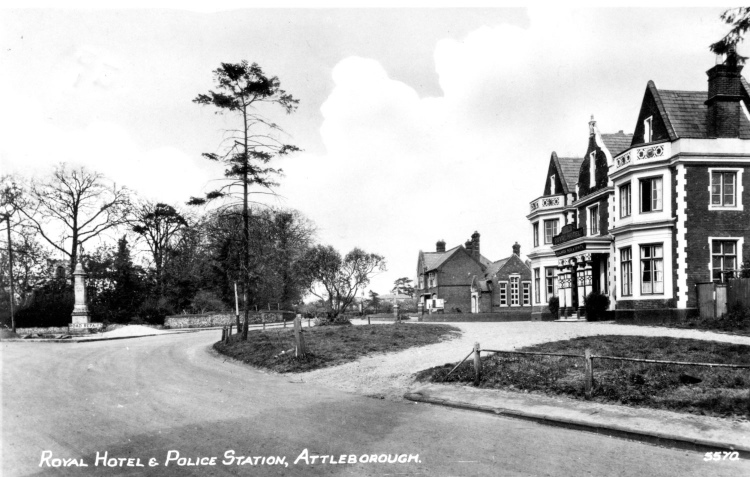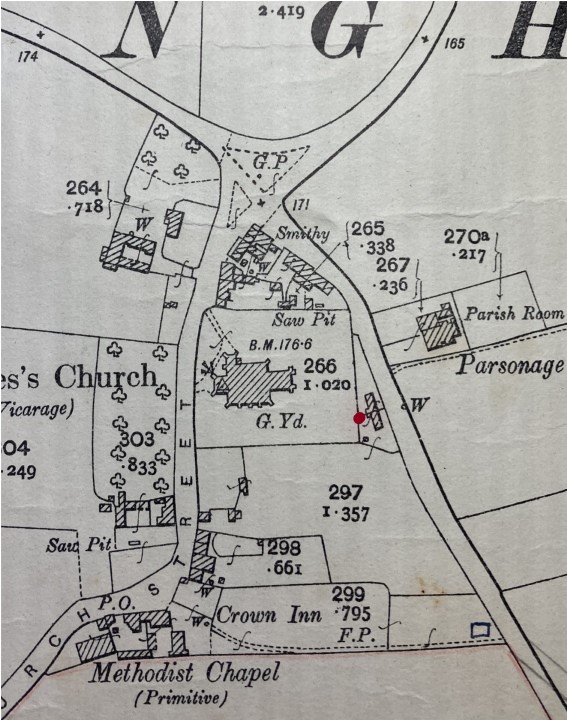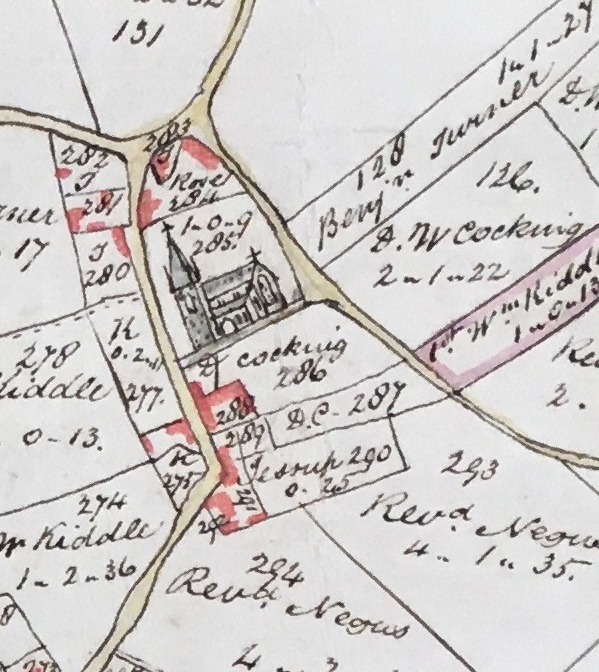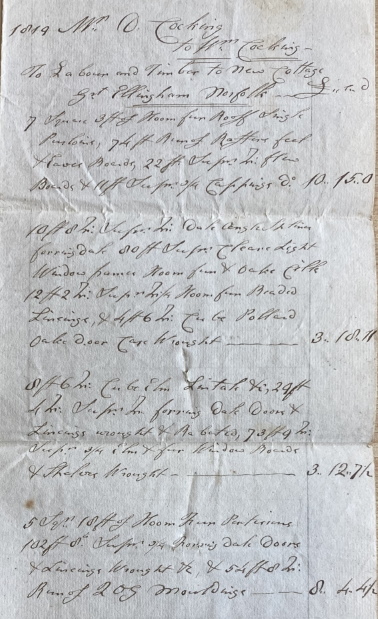A family ownership spanning nearly 150 years came to an end at an auction at the Royal Hotel, Attleborough, on the 23rd June, 1910.

Royal Hotel, Attleborough. Postcard courtesy Brian Vidler
Following the death of Daniel William Cocking Warren, his daughter Annie Matthews Gladden, instructed auctioneers Salter, Simpson & Sons to sell her late father’s property and land in Great Ellingham. The premises and some of the land had been owned by members of the same family since 1769.
The sale included at Lot 3:
TWO CLAY AND TILED COTTAGES and Gardens, each with Sitting-room and Two Bed-rooms, adjoining the Churchyard and Lot 1, and occupied by Messrs. Rosher and Lister. POSSESSION WILL BE GIVEN AT MICHAELMAS NEXT. TENURE - FREEHOLD
Auction Particulars described Lot 1 as a clay and thatched dwelling-house and shop with an adjoining clay and thatched cottage. Later, this property became known as ‘Ye Olde Thatche Shoppe’.

Extract from 1906 Ordnance Survey Map. Second Edition. Surveyed in 1881. Author’s Collection
The red dot on the above extract from an O.S. map of 1906 shows the position of the two clay and tiled cottages. Given that the 1906 map has been drawn from a survey carried out in 1881, it follows that the cottages were built before 1881.
The thatched dwelling-house and shop with the adjoining cottage (later ‘Ye Olde Thatche Shoppe’) lies within the parcel of land numbered 298 on the map.
When were the Cottages built?


Looking at an 1802 map of Great Ellingham (on the left), it is clear that the cottages did not exist at that time. Accordingly, we can be confident that the cottages were built after 1802 (but before 1881).
In 1802, Daniel William Cocking owned the thatched dwelling-house and shop with the adjoining cottage, as well as other nearby cottages. He also owned several parcels of land, including the land on which the two clay and tiled cottages were subsequently built.
Cocking inherited the property and land from his grandfather, Daniel Lister, who had owned the property and most of the land since 1769.
Tithe Map
The two clay and tiled cottages (or at least a building) appear on the 1844 Tithe Map for Great Ellingham.
Abstract of Particulars
An Abstract of Particulars of Great Ellingham dated November 1842 (prepared in connection with the Great Tithes), list the owners and occupiers of most if not all of the properties in Great Ellingham.
William Wenn and Robert Summons are said to be occupying Cocking’s property ‘near the Churchyard’.
Is this property the ‘two clay and tiled cottages’ referred to at the 1910 auction? Quite possibly, as a later deed of 1866 mentions William Whenn as one of the occupiers of the cottages .
1819 Account
Were the cottages built much earlier?
The discovery of an account dated 1819 for labour and timber to a new cottage in Great Ellingham may suggest that the cottages were built earlier than c.1842.
I have mentioned that the cottages were built on land which was (at that time) owned by the same owner as ‘Ye Olde Thatche Shoppe’. The account was found with some historical deeds to this and other nearby property and land owned by Daniel Cocking.
This account, drawn up by Wm Cocking, was addressed to ‘Mr D Cocking of Cambridge’.

Extract from an account Mr D Cocking to Wm Cocking ‘To Labour and Timber to New Cottage Gt Ellingham Norfolk’ dated 1819 sent to Mr D Cocking, Cambridge. All rights reserved by Norfolk Record Office. Catalogue reference: MC 16971 821X7
As you can see from the above extract, some parts of the account are rather challenging to read. However, there is mention of roof ‘purloins’ [purlins] and rafters, as well as eaves boards, window panes, oak cills [sills], pollard oak door, chimnney shelves, brackets and elm lintals [lintels]. The account also mentions the supply of two small gates.
Carpenter William Cocking
Given that I believe that Daniel Cocking never lived in any of his Great Ellingham properties, it is reasonable to assume that ‘Mr D Cocking’ is Daniel William Cocking.
Further, Daniel Cocking’s father, William Cocking, was a carpenter. He and his wife Mary (the daughter of Daniel Lister) lived in Great Ellingham.
Could it be that Daniel Cocking engaged his father to carry out work for him? Why else would the account be with the deeds to Daniel Cocking’s property?
Does the account relate to the construction of the two clay and tiled cottages? If so, it would suggest that the cottages were built in 1819.
However, it could be that Daniel Cocking engaged his father to work on another cottage or cottages in the village – although, I have not (as yet) found any evidence of any other cottage built on Daniel Cocking’s land.
Other References to the Cottages
1866 Mortgage
The next reference to the two cottages is found in a Mortgage Deed dated 2nd March, 1866.
Daniel William Cocking died in 1845. His great nephew and namesake, Daniel William Cocking Warren (then no more than 3 years old), inherited all his great uncle’s property in Great Ellingham.
By 1864, Daniel Warren had reached the age of 21 years. Two years later, Daniel Warren mortgaged all his property and land in Great Ellingham, including:
“also those two cottages or tenements under one roof with the yards, gardens and premises thereto belonging and adjoining situate in Great Ellingham aforesaid near the Public Highway leading from Hingham to Attleborough and now in several occupations of William Whenn and Henry Denmark“
Daniel Warren (then a farmer of Hainford, Norfolk) borrowed £600 (plus interest) from Samuel Townshend Warren and George Studd. Born in Great Ellingham, Samuel Townshend Warren was a corn merchant of East Dereham. Studd, a farmer of Great Ellingham, was married to Samuel Warren’s sister Abigail.
1869 Mortgage
On the 17th September, 1869, Daniel Warren again mortgaged all his property in Great Ellingham. Once again this included the two cottages said to be occupied by William Wenn and Henry Denmark.
At the same time, the £600 debt to Samuel Townshend Warren and George Studd was repaid. The new loan of £600 plus interest was made by the same George Studd (as referred to in the earlier mortgage) and Samuel Warren’s son Frederick Warren, a merchant of East Dereham. In essence, the mortgage was transferred. As it happens, Frederick Warren died on the 5th December 1880.
1894 Transfer of Mortgage
In 1894, £500 of the original mortgage debt to George Studd and Frederick Warren (now deceased) remained outstanding.
On the 24th April, 1894, George Studd transferred the £500 mortgage debt to solicitor’s clerk Charles Endersbye Pearson and chemist Samuel John Hurst. Both Pearson and Hurst lived in Boston, Lincolnshire. Again this mortgage was secured on all of Daniel Warren’s property and land in Great Ellingham, including the two cottages.
Death of Daniel William Cocking Warren
Daniel William Cocking Warren died on the 17th July, 1908. I suspect that his death was unexpected as he died intestate i.e. without leaving a Will. He left a widow, Hannah Maria, and his only child, Annie Matthews Warren, now the wife of George Arthur Gladden.
The 1911 census captures the Gladden family (including widow Hannah Maria Warren) living in a 9-roomed property in Thurton. I believe that Daniel Warren was also living with his daughter and family in Thurton prior to his death.
In consequence of his death, Daniel W C Warren’s property and land in Great Ellingham (including the two clay and tiled cottages) were offered for sale at auction in several lots. The mortgage debt to Pearson and Hurst remained outstanding. However it was later repaid.
1910 New Owner of the Clay and Tiled Cottages
William Downes, of Bury Hall Farm in Great Ellingham, purchased the two clay and tiled cottages from Annie Matthews Gladden and her mother, Hannah Maria Warren, for the sum of £32 10s.
I do not know whether William Downes bid for the property at the auction on the 23rd June, 1910 or whether he negotiated his purchase prior to (or after) the auction.
Nevertheless, I do know that the legal ownership of the cottages was conveyed to William Downes by Hannah Maria Warren and Annie Matthews Gladden on the 22nd November, 1910.
At the time of the purchase, William Downes was a tenant farmer of Lord Walsingham. Later, on the 10th April, 1917, Downes purchased Bury Hall Farm from Lord Walsingham. I assume that William Downes purchased the cottages to house his farm workers.
The 1910 Conveyance Deed to William Downes recites almost exactly the same description of the two cottages as was used some 50 years earlier in the 1864 Mortgage Deed:
All those two cottages or tenements under one roof with the yards, gardens and premises thereto belonging and adjoining in Great Ellingham near the public highway leading from Hingham to Attleborough and adjoining the Churchyard, then formerly in the several occupations of William Wenn and Henry Denmark but then or late of Rosher and Lester [Lister]
1932 Sale to Frederick John Rivett
William Downes retained the ownership of the cottages for the next 20 years or so. Given that he lived at Bury Hall, it is unlikely that Downes ever occupied either of the cottages.
On the 5th December, 1932, Downes sold Bury Hall Farm and the two cottages to local man, Frederick James Rivett. The Conveyance Deed describes the cottages as:
ALL THOSE two cottages or tenements under one roof with the yards gardens and premises thereto belonging and adjoining situate in Great Ellingham afore-said as the same are now in the respective occupations of Charles Edwards and Arthur Lambert being the property conveyed to the Vender by a certain Conveyance dated the twenty second day of November one thousand nine hundred and ten made between Hannah Maria Warren of the first part Annie Matthews Gladden of the second part and the Vendor of the third part
Once again, tenants or employees likely occupied the cottages.
Water Supply
I understand that parts of the village did not have access to a mains water supply until at least 1948. I wondered where the occupants of the cottages obtained their water.
Well
For centuries, the inhabitants of Great Ellingham drew their water from the many wells dotted around the village. Not every dwelling had its own well. Many were shared.
The 1906 O.S. map does not reveal a well within the boundaries of the two cottages. Accordingly, where did the occupiers obtain their water?


If we look again at the 1906 O.S. map (on the right), we can see that there is a well (marked ‘W’) opposite the cottages on the other side of the Attleborough Road. The extract of the 1802 map (left) shows that the well is in land which, in 1802, was also owned by Daniel Cocking.
As far as I can tell, this land (containing the well) remained in the same family ownership as the two cottages, until 1910 when the land and various properties were sold following the death of Daniel W C Warren.
Accordingly, I believe the occupiers of the two cottages obtained their water from the well on the opposite side of the road.
‘Well of Water’ in Different Ownership
However in 1910 following the death of Daniel Warren, the cottages and the land containing the well, were offered for sale at auction in separate lots.
Looking at the 1910 Auction Particulars and Conditions of Sale, Lot 2 comprised:
An Enclosure of ACCOMMODATION ARABLE LAND with Well of Water, being No.271 on Ordnance Map, and containing 4a 2r 20p., or thereabouts, situate on the Attleborough Road, near the Church, and adjoining Property of Lord Walsingham and Mr Wigby, and the Church. Occupied by Mr William Buckle, a Yearly Tenant, at the Annual Rent of £9 10s.
Although the numbering is not shown on the above extract of the O.S. Map, the well serving the two cottages is indeed within the parcel of land numbered 271. In consequence of the auction, the cottages and the well fell into different ownerships.
Did the occupiers of the cottages continue to draw their water from the well which was then not owned by their landlord?
The 1910 Conveyance Deed to William Downes does not include the grant of a right for the owners and occupiers of the cottages to draw water from the well on the opposite side of the road.
Perhaps there was a private agreement between William Downes and the new owner of the well? In any event, I suspect that the lack of a paper right to use the well did not cause any problems for William Downes and his tenants. After all, likely the occupiers/owners of the cottages had been drawing water from the well for many, many years – probably since the cottages were built.
1933 Deed of Easement
In the event, in 1933 (a year after Downes sold Bury Hall and the cottages to Frederick Rivett), Rivett entered into a Deed of Easement with the then owner of the land which housed the well – Obadiah Wigby. Wigby may well have purchased the parcel of land at the auction in 1910.
Frederick Rivett paid Obadiah Wigby the sum of £7 10s for the grant of a right for himself and the occupiers of his cottages to take water from the well.
Wigby covenanted to keep a proper windlass rope and bucket at the well. Rivett covenanted to pay a proportionate part of the expense of keeping the well and the going gears in repair.
1975 Cottages in Separate Ownership
The cottages remained in the ownership of Frederick Rivett until they were individually sold off by his Personal Representatives in 1975, a year after his death.
It was not until 1975 that the properties were owner/occupied. Previously (and for upwards of some 150 years), the cotttages had been occupied by tenants.
Sources:
Deeds and related papers to property in Great Ellingham 1769-1913 1 bundle Norfolk Record Office Catalogue Ref: MC 16971, 821X7
1802 Russell James Colman Plans. Great Ellingham. Norfolk Record Office. Catalogue Ref. C/Ca 1/84.
1799-1842 F W Horner, Records of the Surveyors to Commissioners for Inclosure in Parishes in Norfolk and Suffolk. Great Ellingham (Act 1799). Norfolk Record Office. Catalogue Ref: NRO, BR 90/2
Private Collection – Bury Hall Deeds. Thanks to Emma Wilson